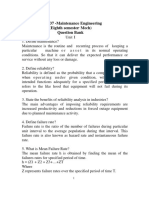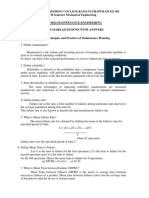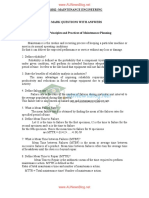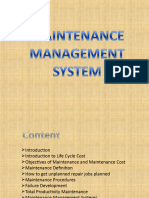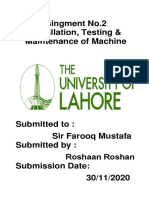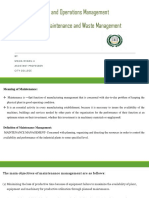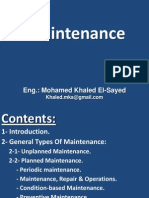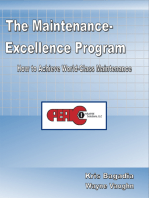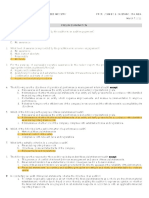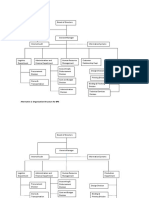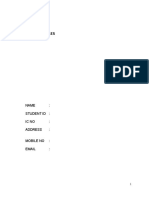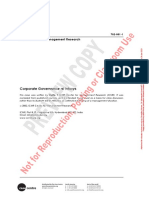Quality Control Past Paper
Uploaded by
FADHILI BENJAMINQuality Control Past Paper
Uploaded by
FADHILI BENJAMINQUALITY CONTROL PAST PAPER
QUESTION ONE
a)Define maintenance strategy
Maintenance strategy refers to a planned approach for maintaining assets, systems, or
equipment to ensure optimal performance, reliability, and longevity. It includes
preventive, predictive, and corrective measures aimed at minimizing downtime, reducing
costs, and maximizing operational efficiency throughout the asset lifecycle
b)Explain the following reactive maintenance strategies
i. Breakdown strategy
Approach involves letting equipment operate until it breaks down, then repairing or
replacing it. It’s typically employed when the cost of preventive maintenance outweighs
the cost of occasional repairs. However, it can result in costly downtime and unexpected
expenses.
ii. corrective maintenance
This strategy focuses on fixing equipment after it has failed. It involves identifying the
root cause of the failure, repairing or replacing the faulty components, and restoring the
equipment to working condition.
c) What is preventive maintenance and what are its components
Preventive maintenance is a proactive approach to maintenance aimed at preventing equipment
failure and ensuring optimal performance by conducting routine inspections, servicing, and
repairs before issues arise. Its components typically include:
Scheduled Inspections: Regular checks of equipment to identify potential issues before they
escalate into failures.
Routine Maintenance Tasks: Planned activities such as lubrication, cleaning, adjustments, and
parts replacements to keep equipment in good condition.
Predictive Maintenance: Using data and analytics to predict when maintenance is needed based
on equipment performance, allowing for timely interventions before failure occurs.
Condition Monitoring: Continuous monitoring of equipment parameters such as temperature,
vibration, and fluid levels to detect abnormalities and trigger maintenance actions.
Training and Documentation: Ensuring maintenance personnel are adequately trained and
equipped with manuals, procedures, and checklists for performing preventive maintenance tasks
QUESTION TWO
a) Explain difference between fixed time maintenance and condition based
maintenance
FTM at predetermient’s condition
FTM involves CBM involves
conducting monitoring the
maintenance tasks condition of
at predetermined equipment in real-
intervals, regardless time using sensors,
of the equipment’s data analysis, or
condition. These visual inspections
intervals are to determine when
typically based on maintenance is
manufacturer needed.
recommendations,
regulatory
requirements, or
historical
maintenance
Maintenance Maintenance
activities are activities are
performed on a triggered based on
regular schedule, predefined
such as weekly, thresholds or
monthly, or indicators of
annually, equipment
irrespective of degradation or
whether the failure, such as
equipment actually abnormal
requires vibrations,
temperature
variations, or fluid
contamination
FTM is relatively CBM allows for
simple to maintenance tasks
implement and to be performed
provides a only when
structured approach necessary,
to maintenance maximizing
scheduling. equipment uptime
and minimizing
maintenance costs.
b) Briefly explain routine maintenance and opportunistic maintenance
Routine maintenance This involves regularly scheduled tasks such as inspections,
lubrication, cleaning, and minor adjustments to keep equipment operating
smoothly and prevent potential issues from developing. It's a proactive approach
to maintenance aimed at maintaining equipment reliability and performance.
Opportunistic Maintenance : This strategy involves taking advantage of
downtime or other operational opportunities to perform maintenance tasks that are not
part of the regular schedule. It allows for addressing maintenance needs as they arise,
potentially reducing downtime and minimizing disruptions to operation
c) What is design maintenance and its difference with maintainability
improvement
Design maintenance involves making modifications or updates to the original design of
a product, system, or equipment to address issues related to maintenance, such as
accessibility for repairs, component reliability, or ease of servicing. It aims to enhance
the maintainability of the system by addressing shortcomings in the initial design.
Maintainability improvement, on the other hand, focuses on optimizing maintenance
processes and procedures without altering the original design. It includes actions such
as improving maintenance schedules, training personnel, or implementing better
maintenance strategies to ensure efficient and effective upkeep of the system.
QUESTION 3
a) Explain the following types of maintenance cost
i. fixed and variable cost
Fixed Costs: These are expenses that remain constant regardless of the level of
production or maintenance activity. Examples include salaries of maintenance staff,
insurance premiums, and facility rent.
a) Variable Costs: These are expenses that fluctuate depending on the level of production
or maintenance activity. Examples include the cost of spare parts, fuel for maintenance
vehicles, and contractor fees for specific maintenance tasks.
ii. direct and indirect cost
Direct Costs: These are expenses directly associated with performing maintenance
activities. They are easily identifiable and can be directly allocated to specific
maintenance tasks. Examples include the cost of labor, materials, and equipment used for
repairs.
Indirect Costs: These are expenses that are not directly attributable to specific
maintenance activities but are incurred as a result of maintenance operations. They are
often overhead costs associated with maintaining facilities, managing maintenance
programs, or supporting maintenance personnel. Examples include administrative
salaries, utilities, and facility depreciation.
iii. capital costs
These are expenses related to acquiring, installing, or upgrading assets or equipment.
Capital costs for maintenance may include the initial purchase price of equipment,
installation costs, and any additional expenses incurred to improve the reliability or
maintainability of assets over their lifecycle. These costs are typically amortized or
depreciated over time rather than expensed immediately
b) What is cost control in maintenance and give specific areas for cost control in
maintenance
Cost control in maintenance refers to the process of managing and minimizing
expenses associated with maintaining assets, systems, or equipment while
ensuring optimal performance and reliability. It involves identifying, analyzing,
and implementing strategies to control costs effectively throughout the
maintenance lifecycle.
Specific areas for cost control in maintenance include:
Labor Costs: Optimizing labor utilization through efficient scheduling, training,
and performance management. This involves ensuring that maintenance
personnel are appropriately skilled, deployed, and utilized to minimize downtime
and maximize productivity.
Material Costs: Managing inventory levels, sourcing materials cost-effectively,
and minimizing waste. This includes implementing just-in-time inventory
practices, negotiating favorable pricing with suppliers, and standardizing parts to
reduce procurement and storage costs.
Equipment Utilization: Maximizing the utilization of maintenance equipment
and tools to reduce maintenance downtime and improve efficiency. This involves
proper maintenance and calibration of tools, as well as ensuring they are used for
their intended purposes to minimize breakdowns and repairs.
Preventive Maintenance: Implementing proactive maintenance strategies to
prevent costly breakdowns and repairs. This includes conducting regular
inspections, servicing, and preventive maintenance tasks to identify and address
issues before they escalate.
Predictive Maintenance: Utilizing predictive maintenance techniques such as
condition monitoring and predictive analytics to anticipate equipment failures
and schedule maintenance activities when necessary. This can help minimize
unplanned downtime and reduce maintenance costs by addressing issues before
they cause major disruptions.
Contract Management: Effectively managing contracts with vendors and service
providers to ensure cost-effective delivery of maintenance services. This involves
negotiating favorable terms, monitoring performance against service level
agreements, and periodically reviewing contracts for cost-saving opportunities.
Energy Efficiency: Implementing energy-saving measures and optimizing
equipment performance to reduce energy consumption and associated costs.
This includes optimizing equipment settings, upgrading to energy-efficient
technologies, and implementing energy management systems to monitor and
control energy usage
QUESTION FOUR
a) Explain key performance indicators of maintenance and state 5 examples
Key Performance Indicators (KPIs) in maintenance are measurable metrics used to
evaluate the effectiveness, efficiency, and overall performance of maintenance activities
within an organization. These indicators help assess how well maintenance processes are
meeting objectives, identify areas for improvement, and drive continuous optimization
Equipment Availability: This KPI measures the percentage of time that equipment is
operational and available for production. It indicates how well maintenance efforts are
preventing unplanned downtime and maximizing equipment uptime.
Mean Time Between Failures (MTBF): MTBF calculates the average time between
equipment failures. A higher MTBF value suggests greater reliability and longer periods
of uninterrupted operation.
Mean Time to Repair (MTTR):
MTTR measures the average time required to repair equipment and return it to
operational status after a failure. A lower MTTR indicates faster response and resolution
times, minimizing downtime and production losses.
Maintenance Cost as a Percentage of Asset Value:
This KPI compares the total maintenance costs incurred over a specific period to the total
value of assets being maintained. It helps assess the cost-effectiveness of maintenance
operations and ensures that maintenance spending is proportionate to asset value.
Inventory Turnover: Assesses the rate at which maintenance spare parts and inventory
are used or replenished. Higher turnover rates indicate efficient inventory management
and minimize excess inventory costs.
c)Explain the following quality based indices in Maintenance
i. Mean Time Between Failure (MTBF): MTBF calculates the average
duration a system or equipment operates before experiencing a failure. It
assesses reliability by dividing total operating time by the number of failures
within a specific period.
ii. mean time between failure
MTBF measures the average duration a system or equipment functions
without failure. It’s calculated by dividing total operational time by the
number of failures, indicating equipment reliability and predicting
maintenance needs.
iii. Mean time Down: MTD quantifies the average downtime of a system or
equipment from failure to restoration. It’s computed by dividing total
downtime by the number of failure incidents, reflecting system availability
and reliability during operations.
d)Explain the following performance based indices
i. Indirect Man Hours: Indirect man hours track time spent on non-
maintenance tasks like planning or administrative work. It assesses
resource allocation efficiency beyond direct maintenance activities,
revealing productivity and operational effectiveness.
ii. Maintenance overtime Maintenance overtime measures additional hours
worked beyond regular shifts to handle maintenance demands. It indicates
flexibility in response to workload fluctuations but may also highlight
resource constraints or inefficiencies.
QUESTION FIVE
a) Define reliability
Reliability is the probability of a system or component performing its function
under specified conditions for a defined period without failure. It assesses
consistency and predictability, crucial for ensuring dependable performance
and minimizing downtime in engineering systems.
b) Explain quality circle and quality improvement team identifying feasible solutions
to quality control
A quality circle is a group of employees from different departments or levels
within an organization who voluntarily come together to identify, analyze, and
solve work-related problems or improve processes related to quality control.
These groups typically meet regularly to brainstorm ideas, share insights, and
collaborate on finding solutions to specific quality-related issues.
On the other hand, a quality improvement team is a more formalized group
tasked with the specific goal of identifying and implementing feasible
solutions to quality control issues within an organization. Unlike quality
circles, quality improvement teams may be assigned specific projects or
initiatives by management and often have access to more resources and
support to carry out their objectives.
Both quality circles and quality improvement teams play crucial roles in
continuous improvement efforts within an organization. They leverage the
collective knowledge, skills, and experiences of employees to identify
opportunities for quality enhancement and implement effective solutions to
improve processes, products, or services. By engaging employees directly in
problem-solving and decision-making processes, these teams foster a culture
of quality, innovation, and continuous improvement throughout the
organization.
c) Explain how reliability prediction helps in performance and maintenance functions
Performance Optimization: Reliability prediction anticipates potential failures, enabling
proactive measures to optimize system design and operation, enhancing performance, and
preventing downtime.
Maintenance Planning: It forecasts equipment failures, aiding in scheduling preventive
maintenance, reducing downtime, and extending equipment lifespan.
Risk Mitigation: Predictions identify failure modes, helping prioritize maintenance efforts to
mitigate risks and ensure operational reliability and safety.
Resource Allocation: Reliability forecasts guide resource allocation, directing resources to
critical areas to prevent failures, minimize costs, and optimize asset performance.
Cost Reduction: Anticipating failures enables cost-effective preventive maintenance, reducing
repair costs, and avoiding costly unplanned downtime, ultimately enhancing profitability.
Decision Support: Reliable predictions provide actionable insights for strategic decision-
making, supporting long-term planning, investment prioritization, and risk management
initiatives to optimize performance and maintenance functions.
You might also like
- Foundations in Accountancy: December 2011: Relevant Dates Examination History Details100% (1)Foundations in Accountancy: December 2011: Relevant Dates Examination History Details2 pages
- Maintenance Engineering Questions and AnswersNo ratings yetMaintenance Engineering Questions and Answers46 pages
- ME2037 - Maintenance Engineering (Eighth Semester Mech) Question BankNo ratings yetME2037 - Maintenance Engineering (Eighth Semester Mech) Question Bank20 pages
- Maintenance Management: Abhinav Kumar BFT/14/884No ratings yetMaintenance Management: Abhinav Kumar BFT/14/88413 pages
- 4.7 (Maintenance Management) MaintenanceNo ratings yet4.7 (Maintenance Management) Maintenance4 pages
- Maintenance Management System Manipal University100% (1)Maintenance Management System Manipal University67 pages
- Effective Maintenance Management: July 2023100% (1)Effective Maintenance Management: July 20239 pages
- Subject: Production and Operations Management Unit 5: Maintenance and Waste ManagementNo ratings yetSubject: Production and Operations Management Unit 5: Maintenance and Waste Management6 pages
- What Are The Different Types of Maintenance SystemsNo ratings yetWhat Are The Different Types of Maintenance Systems30 pages
- Maintenance Activity Process and ManagementNo ratings yetMaintenance Activity Process and Management61 pages
- Strategies for Optimizing Efficiency, Reducing Costs, and Enhancing Workplace SustainabilityFrom EverandStrategies for Optimizing Efficiency, Reducing Costs, and Enhancing Workplace SustainabilityNo ratings yet
- Incident Management Process Guide For Information TechnologyFrom EverandIncident Management Process Guide For Information TechnologyNo ratings yet
- The Concise Calibration & Test Equipment Management Guide: The Concise Collection, #1From EverandThe Concise Calibration & Test Equipment Management Guide: The Concise Collection, #14.5/5 (2)
- Orient Paper Mills, Amlai (Prop. Orient Paper & Industries Limited)No ratings yetOrient Paper Mills, Amlai (Prop. Orient Paper & Industries Limited)2 pages
- SCG - Chartered Accountant - Outsourced Accounting ServicesNo ratings yetSCG - Chartered Accountant - Outsourced Accounting Services11 pages
- Egyptian International Pharmaceutical Industries Company Fundamental Company Report Including Financial, SWOT, Competitors and Industry Analysis0% (1)Egyptian International Pharmaceutical Industries Company Fundamental Company Report Including Financial, SWOT, Competitors and Industry Analysis14 pages
- CPAAOM4016 - Experience-Based Application FormNo ratings yetCPAAOM4016 - Experience-Based Application Form5 pages
- Deed of Partnership: 1. Business ActivityNo ratings yetDeed of Partnership: 1. Business Activity5 pages
- Fundamentals of Accountancy, Business and Management 1: Quarter 3 - Module 2: Accounting Concepts and Principles100% (1)Fundamentals of Accountancy, Business and Management 1: Quarter 3 - Module 2: Accounting Concepts and Principles17 pages
- Audit Management: Gede Leo Nadi Danuarta Kevin Harijanto Caren Angellina MimakiNo ratings yetAudit Management: Gede Leo Nadi Danuarta Kevin Harijanto Caren Angellina Mimaki15 pages
- Fixed Asset Management Powerpoint PPT Template BundlesNo ratings yetFixed Asset Management Powerpoint PPT Template Bundles14 pages
- (Ebook PDF) Skills For Accounting Research, 4e FASB Codification & eIFRS All Chapter Instant Download100% (4)(Ebook PDF) Skills For Accounting Research, 4e FASB Codification & eIFRS All Chapter Instant Download51 pages
- Laboratory Analysis For Critical Food Safety ParametersNo ratings yetLaboratory Analysis For Critical Food Safety Parameters10 pages
- Pathways Guidance From The Examiners (ICAEW)0% (1)Pathways Guidance From The Examiners (ICAEW)13 pages
- Factors Affecting The Acceptance of 4th Year BSA Students Around Cabanatuan City Towards The Section 7 and 9 of The Proposed Accountancy Act of 2021No ratings yetFactors Affecting The Acceptance of 4th Year BSA Students Around Cabanatuan City Towards The Section 7 and 9 of The Proposed Accountancy Act of 202123 pages
- Auditor's Report: To The Shareholders of R. S. Agro & Fertilizer Chemical Industries LTDNo ratings yetAuditor's Report: To The Shareholders of R. S. Agro & Fertilizer Chemical Industries LTD2 pages





